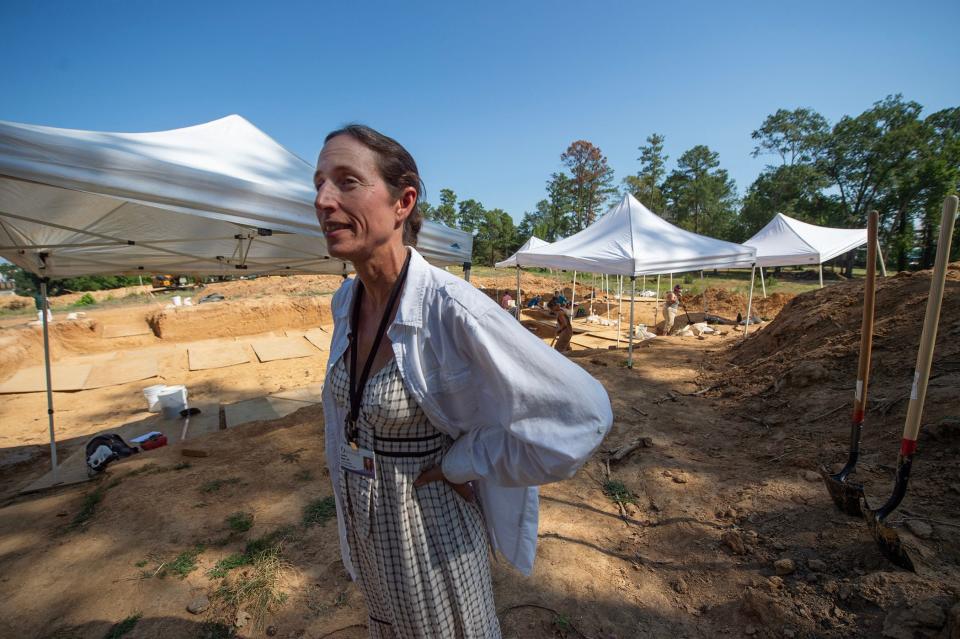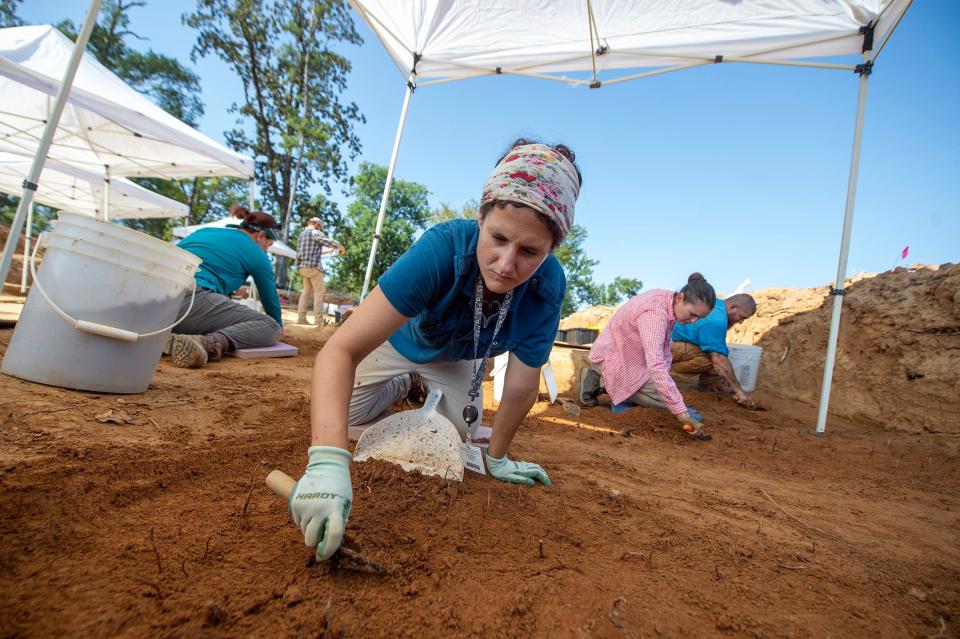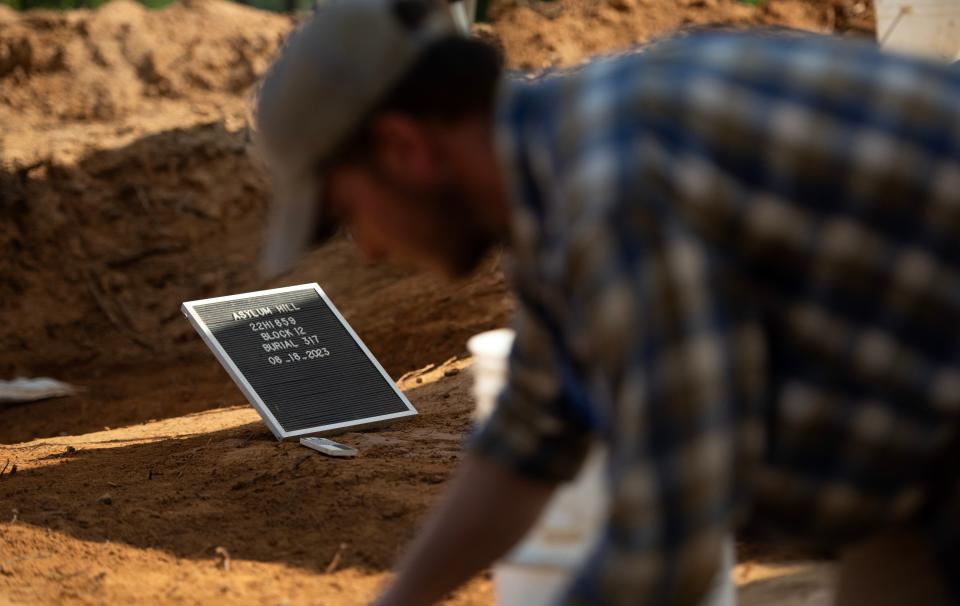Bioarchaeologist project works to exhume, identify some 7,000 asylum patients. Details here
Using just their hands and small shovels to remove soil one scoop at a time, archaeologists have begun the arduous task of exhuming the remains of what may be up to 7,000 people buried at a largely forgotten cemetery near Jackson’s Fondren neighborhood.
Called the “Asylum Hill Project,” the work is focused on property owned by the University of Mississippi Medical Center in the northeast part of their campus, south of Lakeland Drive.
Slated for redevelopment and future expansion by the medical center, the Mississippi Legislature in 2018 passed a bill allowing for exhumation and relocation of the remains located there and two years later $3.7 million was allocated to begin the project.
Jennifer Mack, Ph.D., who is serving as lead bioarchaeologist for the project, explained that the site was originally part of what was known as the Mississippi State Lunatic Asylum, a 140-acre mental hospital operated between 1855 and 1935. It was the predecessor of what is now known as the Mississippi State Hospital at Whitfield in Rankin County.

It is estimated the institution served approximately 30,000 patients for the 80 years it remained in the Fondren area and the cemetery was primarily reserved for patients who died at the hospital and whose bodies went unclaimed by family members.
“Originally there were wooden markers,” Mack said, indicating the names of the deceased. At least one photograph from the early 1960s appears to show some of those original markers, she said, but eventually they deteriorated or were vandalized, and today they are all gone.
Mack said existence of the cemetery was all but forgotten until 2012 when a road crew doing some culvert work on the campus unexpectedly discovered a single grave just south of where the current work is ongoing. That find soon led to the discovery of 65 other graves in the same vicinity.
But, without markers and only scant historical records, how does Mack and her crew hope to identify the thousands of remains?
“The state did not keep official death records until about 1912 but the Mississippi Department of Archives and History does have a searchable database for about 4,000 people buried here between 1912 and 1935,” Mack said.
Additionally, modern DNA research and osteobiography science can be used for identification. Even the soil samples, wood samples and the types of nails used in the coffins can provide key evidence as to the approximate dates of the burials, Mack said.
Still, she describes the process of identification as complex, with the success rate anticipated as low. For remains that can be positively identified efforts will be made to contact surviving family members to see if they want to claim them, Mack said, while the unclaimed and unidentified remains will go to their final resting place at a new mausoleum to be constructed on the campus.
Mack said her team of archaeologists (and a group of college students studying archaeology who assisted as part of a “field school” July 10 through Aug. 4) have found all sorts of interesting items at the 12-acre gravesite: buttons, belt buckles, shoes, even a hair comb.

“Most of the patients were buried in simple wooden coffins, made onsite, wearing a simple gown or shroud,” Mack said.
A few appear to have been buried with their own personal clothing.
All personal items discovered in the graves along with the human remains are being taken to a lab where everything is cleaned and stored, awaiting a full analysis until the excavations end.
The student group, which included 20 undergraduates and two graduate students serving as teaching assistants, was chosen from a group of 45 applicants. The students represented both local colleges, including Millsaps and institutions from other states including California, Arizona and Wisconsin.
“Field school experience is practically required for anyone who wants to get a job in the fields of anthropology and archaeology,” Mack said. The scope of the Asylum Hill Project is also unusually large for the United States. Often students have to fly to Europe or some other overseas destination for their field credits, so the project here in Jackson provided a good opportunity for them, she said.
It is also interesting to note that the field of bioarchaeology, which is defined as the study of human remains in an archaeological context, is largely female dominated. Mack’s staff of professional archaeologists are primarily female and among the group of 45 students applying for the summer field school program, only three were male, Mack said.

Current work is being conducted in what is called “Block 12” of Asylum Hill. The blocks, or groups of burial sites, have been discovered through the use of magnetometry, a process of detecting magnetic fields caused by nails and other metal objects buried underground. Each block discovered thus far contains approximately 30 graves, Mack said.
As of late August, 265 of the estimated thousands of graves have been exhumed, and the work is expected to continue for at least the next seven years, Mack said.
A Pensacola, Florida, native, Mack completed her undergraduate work at Emory University in Atlanta, then spent several years working for private archaeology firms and state agencies, before obtaining her PhD from the University of Exeter in the United Kingdom.
The overall project is being overseen by the Asylum Hill Research Consortium, a group of scholars from various disciplines formed in 2018 to ensure respectful exhumations and memorialize the lives of those buried on the grounds.
Members of the consortium include Eric Hospodor, Dr. Sara Gleason, Dr. Ralph Didlake (Director), Mary Ball Markow, Misti Thornton, Dr. Amy Wiese Forbes, Dr. Caroline Compretta, Dr. Véronique Bélisle; Dr. Thomas Gregory, Dr. Tony Boudreaux, Dr. Patrick Hopkins, Dr. Janice Brockley, Dr. Shamsi Berry and Dr. Molly Zuckerman.
Lida Gibson, well known in the Jackson area as a successful filmmaker and multimedia producer before joining UMMC in 2018, is serving as the Asylum Hill Project Coordinator.
This article originally appeared on Mississippi Clarion Ledger: Bioarchaeologist project ummc jackson ms exhumes, identifies patients

